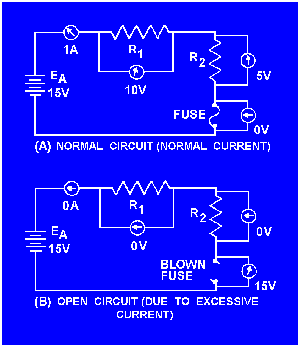|
OPEN CIRCUIT
A circuit is said to be OPEN when a break exists in a complete conducting pathway. Although an open occurs when a switch is used to deenergize a circuit, an open may also develop accidentally. To restore a circuit to proper operation, the open must be located, its cause determined, and repairs made.
Sometimes an open can be located visually by a close inspection of the circuit components. Defective components, such as burned out resistors, can usually be discovered by this method. Others, such as a break in wire covered by insulation or the melted element of an enclosed fuse, are not visible to the eye. Under such conditions, the understanding of the effect an open has on circuit conditions enables a technician to make use of test equipment to locate the open component.
In figure 3-32, the series circuit consists of two resistors and a fuse. Notice the effects on circuit conditions when the fuse opens.
Figure 3-32. - Normal and open circuit conditions. (A) Normal current; (B) Excessive current.

Current ceases to flow; therefore, there is no longer a voltage drop across the resistors. Each end of the open conducting path becomes an extension of the battery terminals and the voltage felt across the open is equal to the applied voltage (EA).
An open circuit has INFINITE resistance. INFINITY represents a quantity so large it cannot be measured. The symbol for infinity is ∞. In an open circuit, RT = ∞.
|
|



